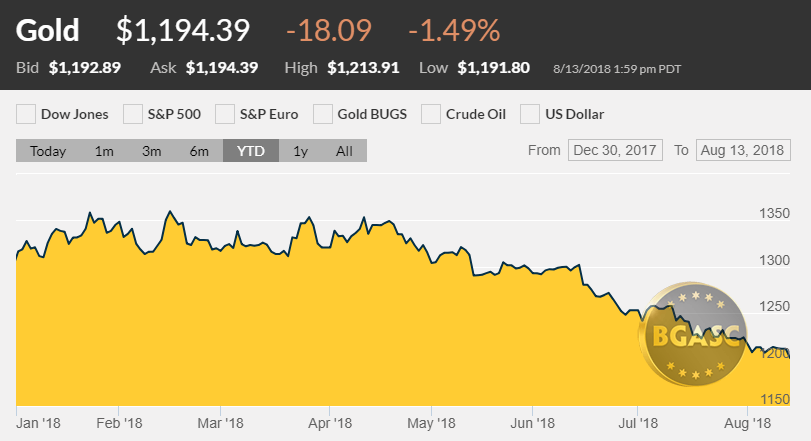
Gold Soars vs Emerging Market Currencies
Gold is often touted as a hedge against financial crisis, inflation, political uncertainty and/or war. As such, gold is often viewed as a “safe haven” asset. Falling gold prices are often an indicator that the public and investors are relatively sanguine about the state of the economy. Alternatively, rising gold prices can act as a harbinger of higher inflation, often referred to as the canary in the gold mine. Rising gold prices can also be seen in economies that are in full blown crisis or collapse.
Current declining gold prices in U.S. Dollar terms might lead people to believe that the economy is on sound footing and inflation quiescent.

While there may not be economic turmoil and inflation in the United States at the moment, other countries are in the throes of economic crisis and the price of gold in those countries’ currencies is soaring.
Gold vs Turkish Lira
The price of gold in Turkish Lira has more than doubled since January 2017. A good portion of those gains occurred in August 2018 as the price of gold in Turkish Lira rose from 5,900 to 8,000 or 36%! The Turkish economy has been under pressure for the past 18 months.
Turkey’s economic problems stem from an excess of bad corporate debt, much of which is denominated in currencies other than the Turkish Lira. As the Lira has depreciated, it has become more difficult to service that debt. Turkey’s tenuous economic situation was exacerbated last week when President Trump announced crushing tariffs on Turkish aluminum and steel.
I have just authorized a doubling of Tariffs on Steel and Aluminum with respect to Turkey as their currency, the Turkish Lira, slides rapidly downward against our very strong Dollar! Aluminum will now be 20% and Steel 50%. Our relations with Turkey are not good at this time!
— Donald J. Trump (@realDonaldTrump) August 10, 2018
What’s happening in Turkey is instructive because it illustrates how fast a currency can collapse and the price of gold go on a tear, perhaps making it impossible for holders of the impacted currency to purchase gold. This highlights the adage that it better to be a few years early than a minute too late. Turks holding gold during this period have been shielded to a large extent from the inflationary impact of the collapsing Turkish Lira.

Turkey is the tenth largest gold holding nation. While the Central Bank of Turkey lists nearly 600 tons of gold on its balance sheet and related Turkish banks, the total value of that gold is around $20 billion, a small amount compared to Turkish total foreign debt and domestic corporate debt totaling well over $400 billion.
Other emerging market currencies in which gold is soaring:
Gold vs. Russian Rouble
While Russia’s GDP ranks about 12th in the world, it is considered an emerging economy with a weak currency. The Central Bank of Russia has been adding gold to its reserves at a furious rate in order to buttress its balance sheet. Russia now holds nearly 2,000 tons of gold worth about $80 billion. Despite the addition of gold, the Russian Rouble remains under pressure.
Gold Price vs. Russian Rouble Since January 2017 – +21%
Gold has risen from 69,000 Roubles in January 2017 to 83,000 Roubles in August 2018
Gold vs. Iranian Dinar
Gold is rising against the Iranian Rial because of the impact of U.S. sanctions and reduced trade. Iranian citizens have been buying gold in anticipation of the impact of these sanctions.
Gold Price vs. Iranian Rial Since January 2017 – +53%
Gold has risen from 36,000 Iranian Rial in January 2017 to 55,000 Rial in August 2018

Gold vs. Argentine Peso
Argentina’s economy has shrunk during most of 2018. Argentina recently had to once again turn to the International Monetary Fund for an emergency loan. As a result of Argentina’s seemingly perennial economic problems, its currency is often depreciating.
Gold Price vs. Argentine Peso Since January 2017 – +94%
Gold has risen from 18,000 Argentine Pesos January 2017 to 35,000 Pesos in August 2018
This article by BGASC is not, and should not be regarded as, investment advice or as a recommendation regarding any particular course of action.
